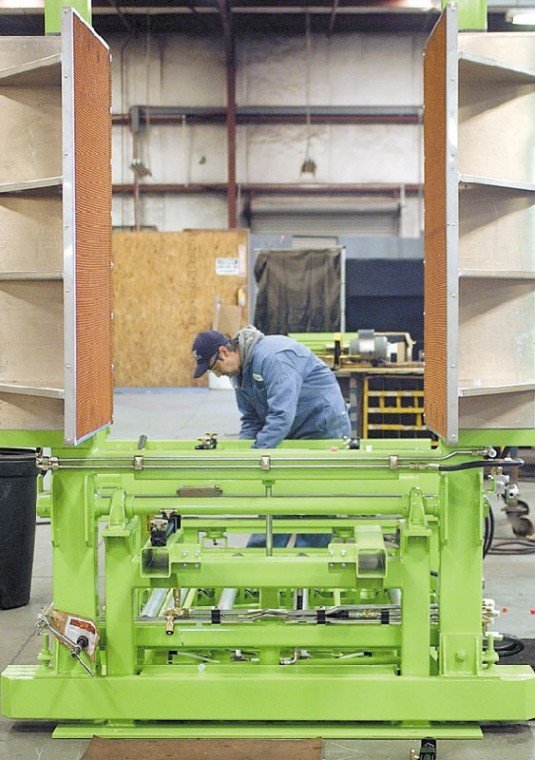Some very unusual companies are operating in the South Valley,
doing everything from making sake to working with bacteria. Here’s
a look at what business as usual means for a few local
companies.
Story by Brett Rowland, Serdar Tumgoren, and Marilyn Dubil, Staff Writers
From sake to bacteria to machines that toss salad, it’s all made right here. There are hundreds of businesses that sell carpet or flowers, serve pizza or tacos and put people up for the night.
But there are few businesses that find their niche, stick to it and become fixtures in the community, though very few people know about them. The following three businesses have done just that.
For the Sake of Hollister
Hollister is widely known as the birthplace of the American biker, but few know that it’s also the birthplace of American-produced sake, thanks to local company Ozeki Sake.
Ozeki, the first major brewer of the 6,000-year-old rice-based beverage in the nation, brought nearly three centuries of company tradition from Japan to Hollister in 1979. And the city of Hollister wasn’t just chosen by chance, said General Manager Kozo Yamamoto.
“We used to export it from Japan and our agent in the United States recommended establishing a site in Hollister,” he said. “Here we have good rice and good water.”
In addition to having very little iron, the water contains the exact elements needed to make fine sake, such as potassium, magnesium and phosphoric acid. And the special rice used to make sake is imported from nearby Sacramento.
Yamamoto, who has been working with the company for more than a decade, took over the plant in 2005 and oversees the production of about 859,000 gallons of sake annually, along with Ozeki’s more than 30 employees.
Prior to 1979, the Ozeki plant on Hillcrest Road was occupied by a company that produced fruit wines, Yamamoto said. The winery was searching for a partner company to share the facility, and after Ozeki analyzed the water supply and proximity to sources of rice, the companies struck a deal. The fruit wine company pulled out years ago, and now Ozeki uses the entire property.
Sake is made from milled, steamed rice sprinkled with koji mold and yeast, mixed with water and then allowed to ferment in huge storage tanks. The rice is sprinkled with koji – a mold that helps convert the starch in rice into sugar that can then be fermented with yeast to give the beverage its distinct flavor – in the “Koji Room.” The Koji Room is a large room lined with cedar panels and kept at very high temperatures to facilitate growth of the yeast. The liquid is then filtered, pasteurized, stored for six months, filtered again and bottled on site. Unlike wine, sake is made continuously throughout the year. A bottle of Ozeki sake can cost anywhere from $5 to $20, depending on type and size.
Sake has been produced in Japan since around 300 B.C. when wet rice cultivation was introduced to that country, but the beverage’s roots go back even further than that, having been made in China as early as 4000 B.C.
Established in 1711, Ozeki is one of Japan’s largest sake brewers. The decision to expand to Hollister turned out to be a good move for the business, Yamamoto said.
“Sake has a long history in Japan, so we don’t see much of a change,” he said. “But consumption in the U.S. is up. The sake business is growing in accordance with the increase in Japanese and Asian restaurants.”
The company’s products are shipped throughout the United States and to more than 30 countries worldwide, including Canada, Russia, Israel and Brazil.
Although most Americans enjoy their sake warm, it can be enjoyed at almost any temperature, Yamamoto said.
“In the summer time, cold,” he said. “And in the winter, warm.”
Ozeki makes nine different varieties of sake, but Yamamoto prefers Ginjo Premier, which retails for about $20 a bottle and contains about 16 percent alcohol – slightly more than wine produced from grapes.
“It’s the premium,” he said.
And not only is it Yamamoto’s favorite, this top-shelf rice wine is considered “one of the highest quality sakes produced” for its fruit flavors and flower-like aromas, according to retail giant Beverages & More.
Yamamoto said the key to making high-quality sake is “polish.” The rice used to make sake is first milled, or polished, to remove the outer layer of the grain and reveal the inner, starchy core of the rice. More polish means higher-quality sake, he said. When making Ginjo Premier, the rice is polished so that no more than 60 percent of the grain remains.
And after 27 years in Hollister, Yamamoto said the company plans to continue producing fresh, high-quality sake for many years to come.
“One of the reasons we brew sake is to bring the fresh taste of sake to our customers,” he said. “Fresh sake is the best – drinking as soon as possible is recommended.”
Toss this salad
If you’ve eaten a bagged salad lately, chances are that one of Gilroy’s homegrown businesses helped get it on your plate.
For almost three decades, Heinzen Manufacturing International has designed and constructed food processing equipment essential to the fruit and vegetable industry.
Tucked away on the edge of farmland in the city’s southeastern industrial hub, the company has more than 400 clients worldwide that include some of the biggest names in the produce industry. Chiquita, Dole and Fresh Express all buy lettuce drying and other processing equipment from Heinzen Manufacturing. The company is among the largest manufacturers in Gilroy, but falls in the middle-weight category in the global market for processing equipment.
But that doesn’t mean the company is content with its niche.
Heinzen earned $20 million this year despite stiff competition from China, Mexico and Europe, and the company can’t get its hands on enough employees to keep up with business. Today, the company has 110 employees that include a stable of in-house engineers and welders.
“We have too much work to do and we can’t find enough people to do it,” said Alan Heinzen, the company founder and a Gilroy resident. “We’re forced to use sub-contractors to get our work done. We’re busy because we do a good job and we have a good reputation.”
Heinzen said the company is looking to hire and train 10 to 20 welders and other workers who can help manufacture food processing equipment. The company makes everything from conveyor belts to dicers, slicers, cubers and food packaging equipment. Much of its work involves custom orders, but Heinzen is best known for its industrial-sized lettuce-dryer – a huge steel drum that can dry 20,000 pounds of lettuce an hour.
“It’s one of the few pieces that don’t change,” said Bert Popowski, a lead fabricator who helps piece together the drum’s stainless steel parts and mechanical components. Each one takes about 250 man-hours. The more people working, the quicker the build, according to Popowski, who said the crew was short a man while one of its workers helped set up equipment in Colorado.
In coming months, the Heinzen engineers, welders and assemblers have their work cut out for them designing and constructing equipment for an entire lettuce processing plant in New Jersey. The job, scheduled for completion in August, will require 11,000 man-hours.
Whether big or small, all the company’s jobs come under the watchful gaze of controller Dan Mitchell.
“We’ve got two things that might be almost exactly alike, but there could be a 12 percent cost difference,” Mitchell explained. “That’s your profit.”
Alan Heinzen, 56, started the company in 1978 from his mother’s garage on Princevalle Street. He used his experience designing equipment for a frozen food processor in Watsonville to stake his own claim in the food industry.
A drawing of cylinders, circles and lines hangs on Heinzen’s office wall off Mayock Drive. It’s a graphical solution his grandfather performed in 1923, Heinzen explains, in the days when engineers relied on books crammed with logarithmic tables to manage their calculations.
For Heinzen, the second of four brothers, the question wasn’t whether or not to become an engineer, but what type of engineer to become.
Their father Lauren Heinzen studied agricultural engineering at California Polytechnic State University at San Luis Obispo, though he had to give up his studies after returning from service in World War II.
“He had four hungry boys to feed,” Heinzen explained.
That didn’t stop Lauren from instilling a love for tinkering in his sons.
“Growing up he would give us engines instead of toys,” Heinzen said. “We had to build our own cars.”
He threw five gallons of blue paint into the deal, recalled Heinzen’s older brother Rick.
“We’re still into blue,” he joked, pointing out the color of his brother’s company shirt.
While Alan toiled away at engines, Rick spent his teen-age years wiring electrical gadgets like a telegraph system. Their younger twin brothers also caught the engineering bug, pursuing careers in the fields of agricultural and civil engineering. Their twin brothers have moved away, while Rick runs an electrical engineering company he created called Mission Control Systems. His office lies a few doors down from Alan’s manufacturing plant on Mayock Road.
Rick’s company designed the electrical control box that runs Heinzen’s signature lettuce drying machine.
“We were always building something,” Alan Heinzen said, joking that he and Rick chose different engineering niches because “we didn’t want to fight.”
The Heinzen brothers chose different paths in engineering, but they share a commitment to the community where they grew up.
The front office wall of Heinzen Manufacturing is covered with plaques and trophies from the various baseball, soccer and softball teams the company has sponsored.
Both brothers have spent years organizing and volunteering for the Garlic Festival, the city’s premier event. In 2001, Rick served as the festival president and this year, Alan Heinzen has taken the reins of the committee that organizes Gourmet Alley.
After months of planning the streamlined process that keeps pepper steaks and penne con pesto churning out to thousands of visitors, Alan plans to once again don a cook’s apron and saute calamari and shrimp under four-foot high flames.
“Alan’s a very generous person,” said Dave Zamzow, a fellow Garlic Festival volunteer and purchasing coordinator for the company.
He sees himself as a prime example of the company’s effort to hire local and promote from within.
Zamzow has known his boss Alan Heinzen from day one.
Heinzen was best friends with Zamzow’s older brother Mark and dropped in at Wheeler Hospital when Dave was born. Three decades later, Heinzen hired his best friend’s brother to help the company secure the raw materials it needs for equipment.
The number one material?
“Lots of stainless steel. Millions of pounds of it” each year, Zamzow said. When he’s not negotiating raw materials, he’s keeping tabs on stock and ensuring new shipments are coming in.
“The biggest thing around here is keeping the lines of communication open,” Zamzow said. “When we do that, we’re a well oiled machine.”
Heinzen would love to see his son Andy or daughter Lindsey, both teen-agers, carry on the family business. His son plans to work at the company this summer, but Heinzen doesn’t have any illusions about the job becoming a career.
“We got engines as toys when we grew up,” Heinzen said. “I think there are too many other choices for kids these days.”
Whoever takes over, Heinzen expects the company to remain rooted in Gilroy for years to come.
Reflecting on his decision to start the company, Heinzen said it was simple: “I chose to do this because I didn’t want to sit in a big office working with electrical stuff all day.”
And why specialize in food?
“People have to eat,” Heinzen said. “They don’t need motorcycles, but they have to eat.”
Raising Bacteria
Anaerobe Systems may not be the smallest business in Morgan Hill, but they are producing perhaps the smallest product.
With 22 employees, including four microbiologists, the company works with bacteria that cannot exist in an environment with oxygen present. Some of them are extremely colorful, making bright red or blue splotches when grouped together.
But the scope of the work that goes on in the laboratories inside the building on Concord Circle is truly global, in no way as miniscule as the bacteria that drive it.
“This is our bread and butter,” President Mike Cox said, describing the hundreds of culture dishes stacking from an assembly line. “You could say we have two parts to our business, the medical and the environmental.”
The company produces equipment used in laboratories, such as petri dishes, on the one hand; the other part of the company’s vision is focused on environmental concerns, ultimately mass production of an alternative energy source.
During a typical day at Anaerobe, employees produce some of the more than 100 products the company offers for medical and research purposes, including the dishes used for cultures in laboratories. Employees also work on computer programs to assist in research and monitor ongoing experiments.
Clearly, what Cox is most interested in is his company’s work with anaerobic bacteria, bacteria that cannot live in the presence of oxygen.
What Cox and his employees are working toward is something that the oil industry would call “disruptive technology,” he said, and environmentalists would welcome: creating useable energy from plants and other readily available sources.
Anaerobe Systems is as much a research facility as it is a product manufacturer. With six patents pending, a main focus of the company is on continuing experimental work with alternative sources of fuel. Cox and his employees check the progress of ongoing experiments, including fermenting bell peppers, garlic, molasses and other food items.
“Some people think there’s an endless supply of natural gas, or we don’t have to worry about running out of oil; by working with our bugs, we have many sources we can use,” Cox said of the bacteria. “It’s just a matter of knowing the bugs, what they like to eat. And they don’t all produce the same results.”
Cox and his researchers graph the results of feeding the bacteria different products; one thing they have found is highly successful with a certain bacteria is molasses. Turning on the valve of a large container of clear liquid, Cox lit a flame that was nearly invisible.
“It burns clean, too,” he said of the hydrogen produced from molasses. Cox plans to use this hydrogen to power a generator behind the company building that will supply power to the plant.
“We’ll use this set up to heat our bugs,” he said. Cox foresees many potential uses for the products created by the anaerobic bacteria’s feasting on different food sources. Potatoes, he said, are particularly useful.
“You can make anything from potatoes that you can make from petroleum,” he said.
Anaerobe Systems also strives for innovation in the medical arena. The company has created a kind of kit for doctors to use in determining which antibiotic will be most effective for a particular patient.
“We’re excited about the kit,” Cox said. “What we’re doing with our medical products, we believe, offers some interesting possibilities.”
About the Businesses
Ozeki Sake
– Established in Hollister in 1979
– Produces 859,000 gallons of sake on-site annually
– Ozeki’s sake sells for between $5 and $20 a bottle
– First major producer of sake in the nation
– The Ozeki company was established in Japan in 1711
Heinzen Manufacturing International
– Design food processing equipment
– Has more than 400 clients, some of which are the largest vegetable and salad producers in the country
– Alan Heinzen started the company in 1978 out of his mom’s garage
– Best known for lettuce-drying equipment
– Lettuce dryers process 20,000 pounds of lettuce an hour
Anaerobe Systems
– Produce more than 100 products company offers for medical and research purposes
– Primary focus on continuing experimental work with alternative sources of fuel
– Employs 22 people
– Working on creating usable energy from plants and other sources















